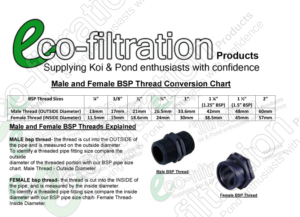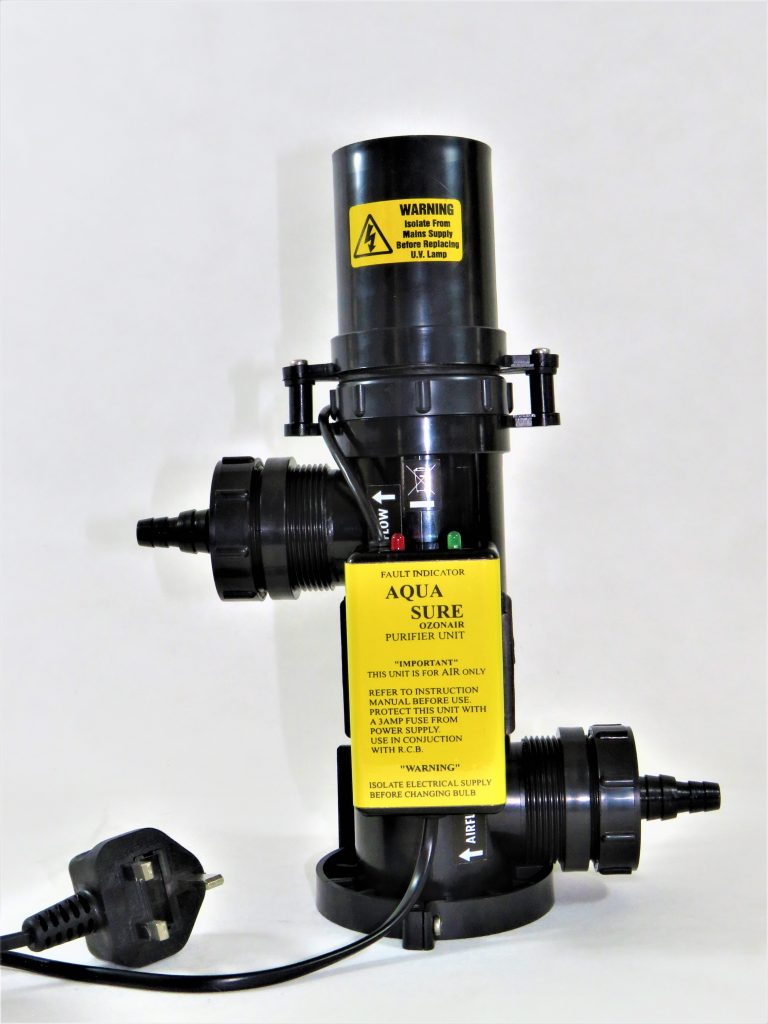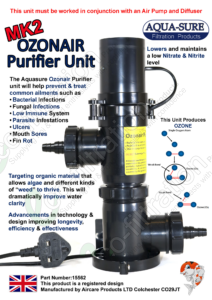
Understanding BSP Sizing
How to Measure Your BSP Fittings When it comes to
Free when you spend £49
99% Are Manufactured In England
Email sam@eco-filtration.co.uk
I was recently contacted by a customer in desperate need of advice and help regarding a reading he took from their pond’s nitrite level, the nitrite level was dangerously high. In fact, the worse I have seen, the nitrite level was + 5.0ppm.
From having further discussions with the customer it was apparent that if this was not treated ASAP his fish could be in a whole world of trouble.
One product we stock and sell is the Ozonair unit. This little unit is remarkable and surprises all our customers when I recommend it for numerous problems that arise in a pond environment.
The Ozoneair unit works by a process of oxidation, once the oxidation process has happened the only molecule left is pure oxygen. Removing any unwanted gas such as nitrate & nitrite
I was contacted by our customer only 12 hours after the Ozonair Unit was installed and running. The Ozonair unit dramatically dropped the nitrite level to a safe level of 0.15ppm.
The pond was not subjected to any partial/water change before the unit was connected, the Ozonair unit really is a versatile product that solves so many common problems faced in a pond environment
If you are experiencing or want to prevent high nitrate and nitrite levels, we couldn’t recommend the Ozonair unit highly enough.
Although nitrite is not as toxic as ammonia, even at low concentrations in the pond, it can be harmful to your pet fish. High nitrite and nitrate levels can cause irreversible damage to your fish’s liver, spleen, nervous system and kidney damage. Nitrite poisoning may even result in the death of your fish.
Ammonia is converted into nitrites by good bacteria called Nitrosomonas. Nitrite is then converted to nitrate. Nitrates are the final product in the reduction of ammonia. Nitrates are generally removed from the pond environment by plants.
When Nitrobacteria break down nitrites in the pond environment nitrates are produced. Nitrates are a natural by-product of the bacterial reduction or removal of ammonia and nitrites in the koi pond ecosystem. Nitrites and Nitrates can become harmful to pond fish if they become abundant and are not removed from pond water. Both can lead to fish mortality if not kept in check.
You may notice fish gasping at the pond surface or hanging near air stones if nitrite becomes problematic. High nitrite concentrations can result in a condition known as ‘brown-blood disease’. Brown-blood disease occurs in fish when their pond water contains high nitrite levels. Nitrite enters the fish’s bloodstream through the gills and prevents the red blood cells from absorbing vital oxygen from the water. It turns the fish’s blood to a chocolate-brown color. Hemoglobin, which transports oxygen in the blood, combines with nitrite to form methemoglobin, which is incapable of oxygen transport. Brown blood cannot carry sufficient amounts of oxygen through the fish’s system; therefore the affected fish can suffocate regardless of adequate oxygen concentration in the pond water. This accounts for the gasping behavior often observed in fish with a brown blood disease, even when oxygen levels are relatively high.
The ideal range for nitrite is 0.00 parts per million. A reading of 0.25 ppm or higher is dangerous to your fish and indicates that you need to take immediate action to reduce the nitrite level in your koi pond.
Every koi keeper should own a simple test kit to test the water quality of their pond water. Toxic chemicals such as ammonia, nitrite, nitrate and others are not apparent visually. Perfectly clean clear pond water can contain dangerous, even lethal levels of toxic chemicals.
Accumulation of nitrates can cause problems such as damage to the veins in koi fins and skin, depressed immune system, and even reproductive problems. Koi in high nitrate conditions may act dull or lethargic but perk up and become energetic for a feeding then quickly return to the prior state of lethargy. Often, fish that are subjected to high nitrate accumulations over time will experience slowed growth, delayed wound healing and will become extremely susceptible to illness and parasitic infestations.
The ideal range for nitrate is 20-60 ppm, parts per million. If your pond reaches 80 ppm you should begin a regiment of partial water changes to reduce nitrates to a safe level. Nitrate becomes extremely toxic above 120 ppm.
If you encounter a situation where the ammonia, nitrite or nitrate are rising to toxic or lethal levels you should do an immediate water change of at least 1/3 – ½ of the total system. The newly added freshwater will not resolve problems associated with high or toxic chemical pollutants, it only dilutes them to a level acceptable to your fish. Alternatively, in the unfortunate event that your koi are becoming very ill due to extreme deterioration of water quality, you could increase the amount of water exchanged to 20-30% daily for a short period of time.
Increased nitrite levels usually mean the necessary good bacteria in your pond that turn nitrite into nitrate have not developed in sufficient numbers. For the time being, the best things you can do is to increase the aeration and perform partial water changes. Additionally, there are several good bacteria products on the market that you can add to the pond. These should help increase the bacteria colonies quicker than they will colonize naturally.


How to Measure Your BSP Fittings When it comes to

In this short article, I’m hoping to clarify a few
Pond care can be time consuming and difficult, especially when